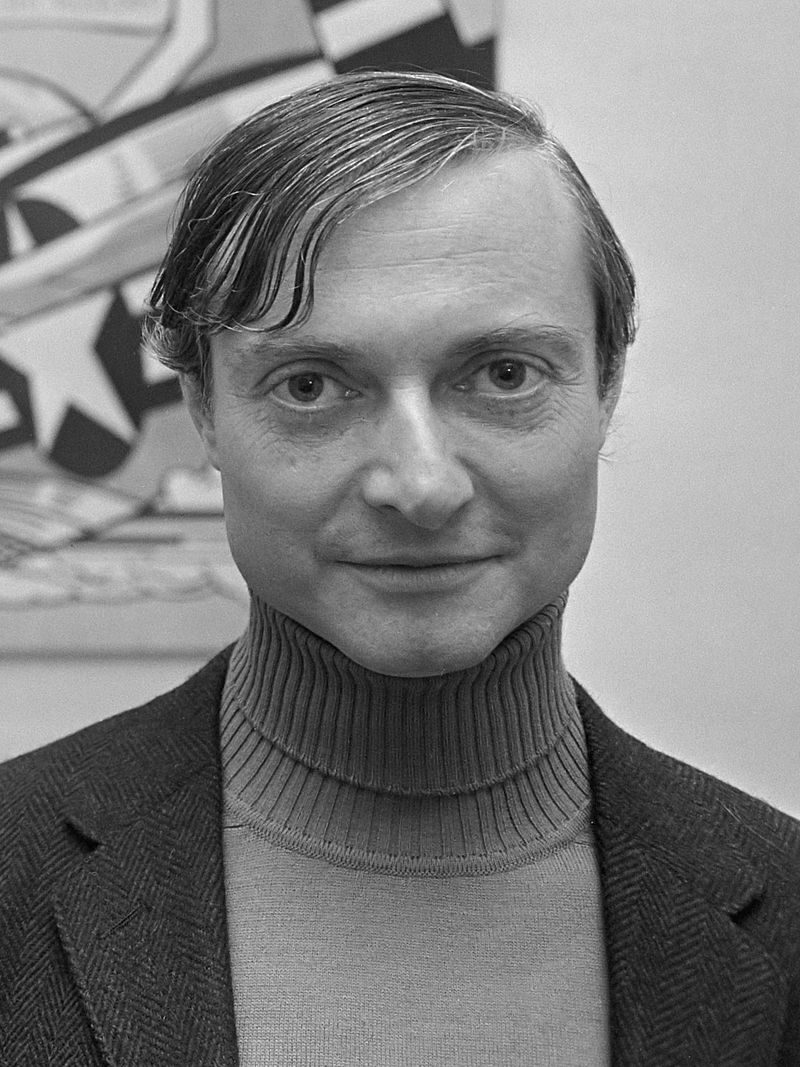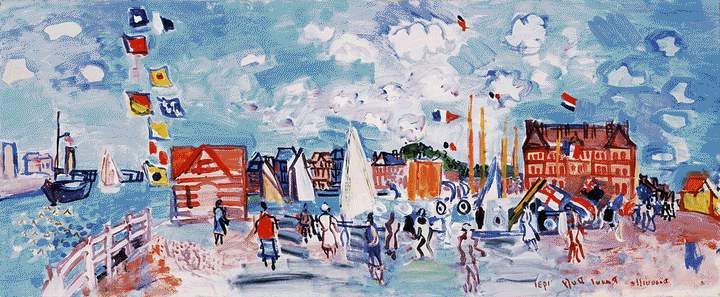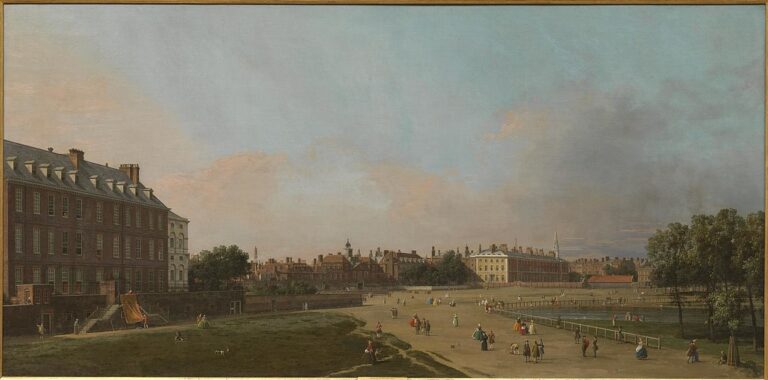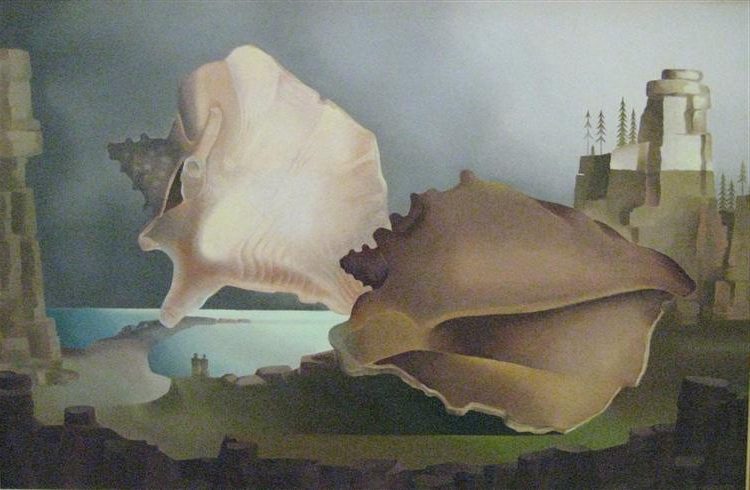Roy Lichtenstein Painter: The Pioneer of Pop Art Movement
Born: October 27, 1923, New York City, U.S.
Death: September 29, 1997, New York City, U.S.
Art Movement: Pop Art
Nationality: American
Teacher: Reginald Marsh
Institution: Art Students League of New York and Ohio State University
Roy Lichtenstein Painter: The Pioneer of Pop Art Movement
Life and Education of Roy Lichtenstein
Roy Lichtenstein’s journey from a young art enthusiast to a renowned pop artist was shaped by his formal education and early life experiences. His academic background and teaching career provided a foundation for his innovative artistic style.
Early Years and Influences
Roy Fox Lichtenstein was born in 1923 in New York City. From an early age, he demonstrated significant artistic talent and creative interests.

Preparedness, 1968 by Roy Lichtenstein
As a teenager, Lichtenstein actively pursued his artistic abilities by drawing, painting, and sculpting. He spent considerable time at the American Museum of Natural History, which likely influenced his visual perspective.
His formal art education began in 1937 when he took watercolor classes at the Parsons School of Design. In 1940, Lichtenstein furthered his training at the Art Students League, studying under American instructors who helped shape his early technique.
This early education was interrupted when he served in the military during World War II, an experience that would later influence his artistic themes.
Academic Pursuits and Teaching
After his military service, Lichtenstein attended Ohio State University where he deepened his artistic knowledge and technical skills. This educational period proved foundational for his later work.
From 1946 to 1951, he transitioned from student to teacher at Ohio State University. This dual role allowed him to develop his own artistic vision while guiding others.
Lichtenstein’s academic career later expanded to include teaching positions at the State University of New York, Oswego. These teaching experiences provided him stability while he developed the distinctive pop art style that would make him famous.
His academic background gave him a thorough understanding of art history and techniques, which he would later subvert and transform in his iconic comic-inspired paintings and bold visual statements.
Artistic Style and Development
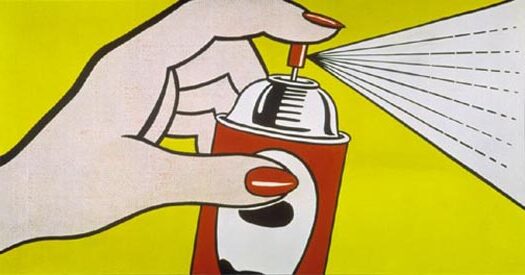
Spray (1962) by Roy Lichtenstein
Roy Lichtenstein’s artistic journey was marked by his distinctive visual language and technical innovations. His style evolved from Abstract Expressionism to become one of Pop Art’s defining voices through his unique approaches to color, line, and cultural commentary.
Emergence into Pop Art
Lichtenstein began his career creating abstract expressionist works in the 1950s, a far cry from the style that would later make him famous. His shift toward Pop Art began around 1961 when he started incorporating cartoon images into his paintings. This dramatic change was inspired by a challenge from his young son, who pointed to a Mickey Mouse comic book and said, “I bet you can’t paint as good as that.”
The artist’s first major Pop painting, “Look Mickey” (1961), marked this pivotal transition. In this work, he borrowed imagery from a children’s book, establishing his signature approach of appropriating commercial art.
By 1963, Lichtenstein had fully embraced Pop Art, rejecting abstract expressionism’s emotional intensity for cool, detached images from consumer culture.
The Benday Dot Technique
Lichtenstein’s most recognizable technique was his adaptation of Benday dots, a commercial printing process used in comic books and newspapers. He meticulously hand-painted these dots to mimic mechanical reproduction while intentionally making them more uniform and deliberate than their printed counterparts.

Yellow and Green Brushstrokes, 1966 by Roy Lichtenstein
These dots became his visual signature, creating areas of color and tone that mimicked industrial printing processes. Unlike actual printing dots, Lichtenstein’s were precisely calculated and evenly spaced.
The technique transformed mass-produced images into fine art, challenging traditional notions about originality and artistic skill. His dots also created a visual tension between the mechanical appearance and the actual handmade nature of his work.
Influence of Mass Media and Comic Strips
Comic strips provided Lichtenstein with both imagery and narrative elements that became central to his work. He carefully selected, cropped, and redesigned panels from romance and war comics, transforming throwaway entertainment into monumental art.
His paintings often featured melodramatic scenes with speech bubbles containing phrases like “WHAAM!” or “OH, JEFF…I LOVE YOU, TOO…BUT…” These works commented on American culture’s emotional stereotypes and commercial storytelling.
Lichtenstein didn’t simply copy comics; he refined and intensified their visual impact. He eliminated unnecessary details and heightened color contrasts to create more powerful compositions.
His work blurred the line between “high” and “low” art forms, challenging the art world to reconsider the cultural significance of mass media imagery.
Experimentation with Sculpture and Collage
Though best known for his paintings, Lichtenstein expanded his artistic vocabulary to include sculpture in the 1960s. His three-dimensional works translated his graphic style into physical form, often featuring his characteristic bold outlines and primary colors.
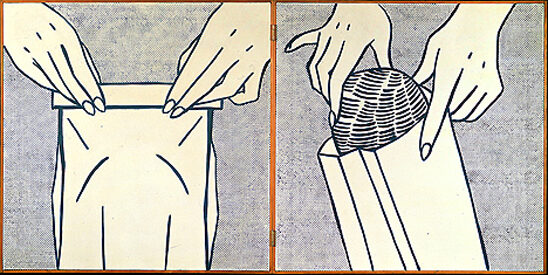
Bread in Bag (1961) by Roy Lichtenstein
In the 1970s, he created a series of brass and painted aluminum sculptures that explored the representation of reflections and transparency. These works demonstrated his ongoing interest in how images are constructed and perceived.
Lichtenstein also experimented with collage, combining painted elements with actual materials. His “Entablatures” series (1970s) incorporated molded plastic with painting to reference classical architectural elements.
Throughout these explorations, he maintained his interest in how images are constructed, perceived, and distributed in modern culture, proving that his artistic vision extended well beyond two-dimensional painting.
Notable Works and Legacy
Roy Lichtenstein’s artistic contributions transformed the art world through his distinctive style and innovative techniques. His bold works continue to influence artists and captivate audiences worldwide.
Major Paintings and Series
Lichtenstein’s breakthrough came with his comic book-inspired paintings in the early 1960s. “Whaam!” (1963) stands as one of his most iconic works, depicting a dramatic aerial combat scene using his signature Ben-Day dots and bold outlines. This piece exemplifies his ability to transform commercial imagery into fine art.
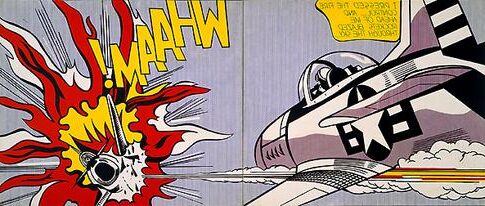
Whaam! (1963) by Roy Lichtenstein
His “Brushstrokes” series (1965-1966) cleverly commented on Abstract Expressionism by turning spontaneous gestures into calculated, mechanical reproductions.
Lichtenstein also created parodies of famous paintings by masters like Picasso and Mondrian, reimagining them in his distinct style. His “Landscapes” series of the 1960s and 1970s reduced natural scenery to simplified patterns, continuing his exploration of representation and perception.
Later works like the “Mirrors” and “Reflections” series demonstrated his ongoing fascination with light, space, and optical illusions.
Contributions to Print and Drawing
Beyond painting, Lichtenstein was a prolific printmaker who embraced various techniques. His screenprints and lithographs further explored his comic-inspired aesthetic while reaching wider audiences through multiple editions.
In the 1990s, he produced innovative works combining different printing methods. His “Reflections” print series demonstrated his mastery of technical processes while continuing his exploration of imagery and perception.
Lichtenstein’s drawings reveal his meticulous planning process. His preparatory sketches show how he transformed source material into his distinctive style through careful composition and color selection.
His experiments with different materials and techniques, including painted bronze sculptures that appeared two-dimensional, challenged traditional boundaries between artistic mediums.
Impact on Contemporary Art and Artists
Lichtenstein’s bold aesthetic continues to influence generations of artists. His work helped legitimize commercial imagery as a subject for fine art, bridging the gap between “high” and “low” culture.
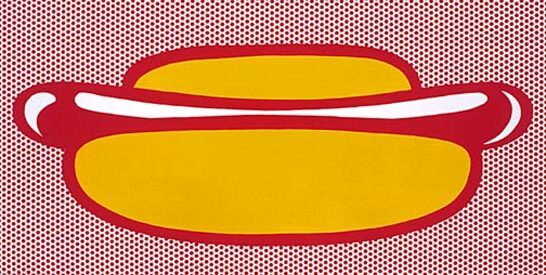
Hot Dog by Roy Lichtenstein
Contemporary artists frequently reference his distinctive style. His influence extends beyond visual art into graphic design, advertising, and popular culture.
Major museums worldwide feature Lichtenstein’s work in their permanent collections. The Roy Lichtenstein Foundation, established after his death, preserves his legacy through research and exhibitions.
His market value has skyrocketed, with paintings selling for tens of millions at auction. This commercial success reflects his enduring appeal and cultural significance.
Lichtenstein’s approach to appropriation and recontextualization of existing imagery anticipated key aspects of postmodern art practice that remain relevant today.
Frequently Asked Questions
Roy Lichtenstein’s work often prompts curiosity about his techniques, influence, and artistic legacy. Below are answers to common questions about this pioneering Pop artist who transformed comic imagery into fine art.
What techniques did Roy Lichtenstein employ in his artwork?
Lichtenstein developed a distinctive technique using Ben-Day dots, bold outlines, and primary colors. These dots mimicked commercial printing processes used in comic books and advertisements.
He often created stencils to achieve precise, mechanical-looking results. His process involved projecting images onto canvas, then meticulously painting each element.
Lichtenstein used flat colors with little to no shading, emphasizing the two-dimensional quality of his work. He deliberately removed brushstrokes to create clean, commercial-looking images.
What is Roy Lichtenstein best known for in the art world?
Lichtenstein is best known for elevating comic book imagery to high art. His large-scale paintings of comic panels complete with speech bubbles and thought balloons brought popular culture into fine art galleries.
He challenged traditional notions of originality and authorship by appropriating existing commercial images. His work questioned the boundary between mass culture and high art.
His bold style using primary colors, black outlines, and Ben-Day dots became instantly recognizable worldwide.
How has Roy Lichtenstein influenced modern pop art?
Lichtenstein helped establish Pop Art as a legitimate art movement in the 1960s. His technique of elevating commercial imagery influenced generations of artists who explore popular culture.
His work bridged the gap between commercial design and fine art, challenging old hierarchies. Contemporary artists continue to reference his distinctive style when commenting on consumer culture.
Digital artists and graphic designers still draw inspiration from his bold colors and dot patterns. His influence extends to advertising, fashion, and graphic design.
Can you name some of Roy Lichtenstein’s most famous works?
“Whaam!” (1963) depicts a fighter jet firing a missile at an enemy plane. This large diptych became one of his most recognized works.
“Drowning Girl” (1963) shows a tearful woman in a turbulent sea with a thought bubble reading “I don’t care! I’d rather sink than call Brad for help!”
“Look Mickey” (1961) is considered his first true Pop Art painting, showing Mickey Mouse and Donald Duck fishing. Other notable works include “Oh, Jeff…I Love You, Too…But” (1964) and “In the Car” (1963).
What are some interesting aspects of Roy Lichtenstein’s personal life and career?
Lichtenstein began his career as an abstract expressionist before finding his Pop Art style in his late 30s. He served in World War II, which later influenced some of his war-themed artwork.
He was friends with artist Irv Novick, whose comic panels he later adapted into some of his most famous paintings. This personal connection adds an interesting dimension to his appropriation of comic art.
Lichtenstein was known for his methodical, disciplined approach to creating art. He maintained a regular studio schedule throughout his career.
How do art historians assess the legacy of Roy Lichtenstein’s work?
Art historians view Lichtenstein as a key figure who helped redefine what could be considered fine art. His work challenged the divide between high culture and mass media.
Some critics initially dismissed his work as simple copying, but most now recognize the conceptual depth behind his appropriation. His commentaries on American consumer culture and art itself are seen as increasingly relevant today.
His technical precision and conceptual approach have secured his place as one of the most important artists of the 20th century. His influence extends far beyond Pop Art into contemporary visual culture at large.


